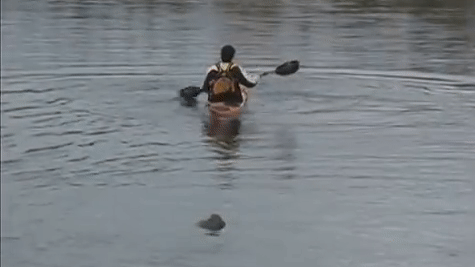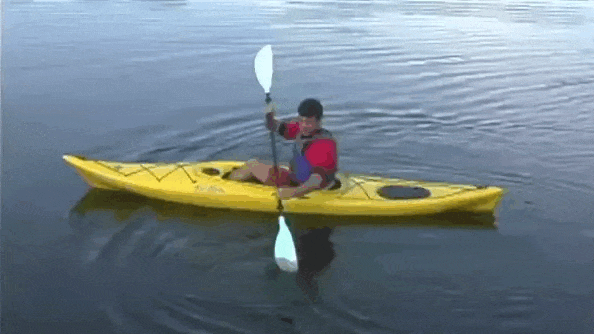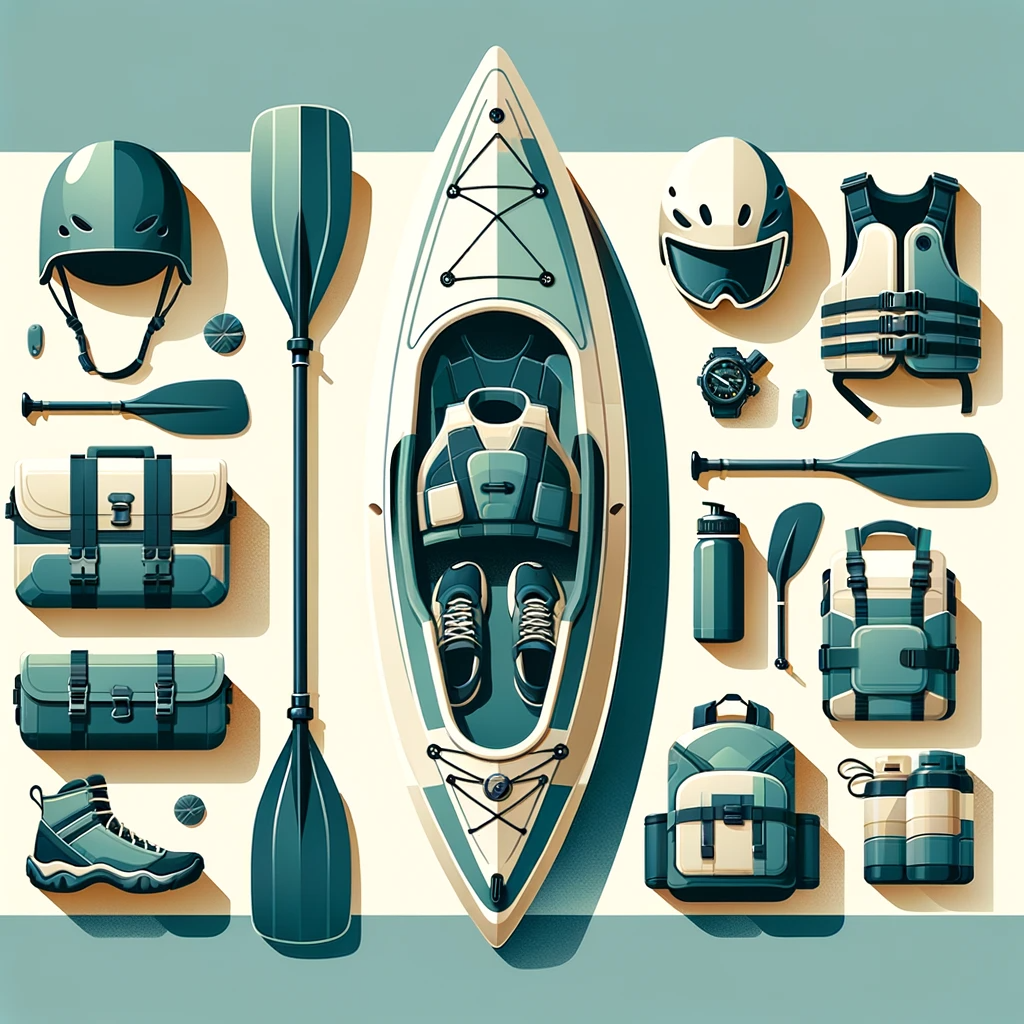Struggling to get started with kayaking? You’re not alone. Many kayaking beginners feel overwhelmed when they think about entering the world of kayaking. In fact, The 2023 Outdoor Participation Trends Report highlights a significant growth in outdoor recreation participation. In 2022, the number of participants reached a record 168.1 million, representing 55% of the U.S. population.
These trends reflect a broadening appeal of outdoor activities, including kayaking, across various demographics. But where do you begin? This guide is your starting point. It simplifies the process, giving you the essentials to confidently embark on your kayaking journey.
So let me tell you, I’ve been where you are and understand the challenges you face. This guide, packed with beginner kayaking tips, is designed to reassure and guide first-time paddlers.
Over the years, I’ve transitioned from a complete novice to a seasoned kayaker, learning valuable lessons along the way. This guide is a distillation of that experience, aimed to help you avoid common pitfalls and start enjoying the water sooner.
Is Kayaking Difficult for Beginners?
Understanding the Basics of Kayaking
Kayaking can be a fun and rewarding outdoor activity, but it’s understandable for beginners to wonder if there’s a steep learning curve. While there are certainly some skills involved in kayaking, the good news is that it’s relatively easy to pick up the basics, even for those with no prior experience.
The initial steps involve mastering proper paddling techniques, maintaining balance, and understanding the basic maneuvers for turning and maneuvering the kayak. Once these basics are grasped, beginners can quickly progress to more advanced techniques and explore different kayaking environments.
For an even faster progress you can check out these common beginner kayaking mistakes so you don’t make them yourself! Starting with a ‘sit-in kayak’ is beneficial for those interested in learning proper foot position and control, as it allows for a more secure and controlled paddling motion.
Common Challenges for Kayaking Beginners and How to Overcome Them
Overcoming Fear of Water: Some individuals may experience fear or anxiety when paddling in water. This is understandable, as water can be unpredictable and potentially dangerous.
To overcome water fear, it’s helpful to start in shallow areas and practice gradually increasing the distance from the shore.
Steering Struggles: Steering might seem complex, but it’s all about coordination. Your paddles are your guides. Practice in calm waters, focusing on how each stroke affects the kayak’s path.
Paddling Fatigue: Your arms might tire quickly, but this lessens with time. Paddle in short bursts and take breaks. Your endurance will build up like a runner’s does over time.
Overcoming Frustration: It’s normal to feel a bit frustrated. Remember, every expert kayaker started as a beginner. Laugh at the splashes, enjoy the process, and keep paddling.
Maintaining Balance: Feeling stable in a kayak can be a concern for beginners. This is especially true in calm waters, where the slightest shift or movement can tip the kayak over.
To maintain balance, it’s important to sit upright, distribute weight evenly, and practice keeping your eyes focused ahead. Starting in calm areas and gradually increasing the difficulty level as you gain confidence can help improve balance.
Remember, kayaking is a journey, not a sprint. Take it one stroke at a time. In the next section, we’ll dive into the first rule of kayaking, ensuring you start your paddling adventure with safety as your top priority.
What is the First Rule of Kayaking?
There are many opinions on this particular question, but in my view, the first and most important rule in kayaking — Always respect the water. Whether you’re paddling on a calm lake or navigating a river, understanding that nature is in charge sets the stage for a safe experience.
Safety first!
If you’re planning a paddling adventure, safety should be your top priority. The American Canoe Association (ACA) offers an essential Paddler’s Safety Checklist that every kayaker, canoeist, and paddle boarder should review before hitting the water. Here’s what you need to know:
Be a Swimmer: Ensure you’re comfortable and capable in the water.
File a Float Plan: Let someone know your plans—where you’re going and when you expect to return.
Wear Your Lifejacket: Always have a properly fitting personal flotation device (PFD).
Understanding your environment is crucial, so:
Know the Weather Forecast: Check updates regularly to avoid any surprises.
Know the Water Venue: Familiarize yourself with the area you’ll be paddling in.
Carry a Compass, Chart, or Map: Navigation tools are vital for safety and orientation.
Your clothing and gear matter as well:
Wear Appropriate Clothing and Kayak Gear: Dress for the water temperature, not just the air temperature, and ensure you have the necessary personal items for different weather conditions and outings.
Wear a Hat: Protect yourself from the sun and elements.
Wear Proper Footwear: Your feet need protection in and out of the water.
Don’t forget these essentials:
First Aid Kit & GPS Locator: For emergencies and tracking your location.
Carry a Whistle: A simple tool for signaling help.
Rescue Gear: Be prepared for self-rescue or to aid others.
Additional items include:
Bilge Pump: To remove water from your vessel.
Sun Protection: Sunscreen with a high SPF to shield from harmful rays.
Drybag with Extra Clothing: Keep additional layers dry in case you need them.
Following this checklist can help ensure a fun and safe experience on the water. Don’t cut corners on safety—your life and the lives of others may depend on it. Planning a safe kayaking trip involves reviewing the ACA’s Paddler’s Safety Checklist.
What is a Good Kayak for Beginners?
For a kayaking beginner, selecting the right kayak stands as the first real challenge. It’s not about grabbing any old boat. A beginner’s kayak needs stability, comfort, and a touch of forgiveness for those inevitable mistakes.
Picture a kayak that steadies itself when you wobble and doesn’t turn a simple mistake into a swim. These qualities matter. Considering tandem kayaks can be beneficial for beginners wishing to kayak with a partner.
Tandem kayaks, with their two seats, require synchronization between paddlers but offer the advantage of shared power, making them efficient for pairs. They also have bigger hulls for storage, ideal for overnight trips.
3 most important consideration when choosing a kayak
Stability emerges as the paramount feature. Look for wider kayaks; they offer better balance. Think of them like a steady old dog that won’t easily topple over. This extra width might slow you down, but speed is not your friend at the start. You want a boat that won’t flip at the first sign of trouble.
Comfort comes next. You’ll spend hours in this vessel, so it better be kind to your back and legs. Adjustable seats and footrests make a world of difference. They’re like the comfortable chair in your living room that you never want to leave.
Durability also plays a key role. Beginners often scrape rocks or beach their kayaks more than seasoned paddlers. A rugged material, like polyethylene, can take a beating and keep floating. It’s the sturdy workhorse of kayak materials.
Recreational kayaks are particularly advantageous for beginners due to their stability and suitability for new paddlers.
These kayaks often come with adjustable foot braces, enhancing comfort and control, making them an excellent choice for those just starting out. Events like ‘Paddlefest’ offer a fantastic opportunity to try out different brands and models, ensuring you find the perfect fit for your kayaking adventures.
Inflatable kayaks also present a beginner-friendly option, with their ease of storage and resistance to damage making them ideal for those new to the sport. Their lightweight design and durability against river rocks or during transportation add to their appeal for beginners looking for a reliable and convenient kayak.
Or if you feel overwhelmed…
Simply, look for simplicity in design. A kayak cluttered with gadgets and complex features might overwhelm you. Remember, simple is often better. A few well-placed handles for carrying, a straightforward seating area, and minimalistic storage will serve you well.
When selecting your first kayak, consider a model that offers stability, comfort, durability, and simplicity. This kayak will be your reliable companion as you explore the exciting realm of paddling. Furthermore, you can always look into buying a used kayak, which would be an excellent option for first timers.
For more detailed guidance on choosing the right kayak, refer to the comprehensive buying advice provided at OutdoorGearLab.
Next, we delve into the crucial techniques essential for mastering the art of kayaking, ensuring a smooth start to your paddling journey.
How to Select the Right Paddles and Life Jackets
Choosing Paddles:
Length: Your height and the width of your kayak determine the paddle length. Taller people or wider kayaks require longer paddles.
Material: Paddles come in materials like aluminum, fiberglass, or carbon fiber. Lighter materials mean less fatigue, but they can be pricier.
Blade Shape: Wider blades offer more power, while narrow blades are easier for longer trips. The shape of the paddle blade and paddle blades significantly impacts paddling efficiency, affecting how water is caught and released with each stroke.
Understanding the importance of the paddle shaft is crucial for effective paddling. Correct hand placement and orientation on the paddle shaft ensure better control and power transfer during paddling.
For a more detailed guidance, refer to our comprehensive article about buying kayak paddles!
Selecting Life Jackets:
Fit: It should fit snugly but not restrict your breathing or movement. Always try it on before buying.
Buoyancy: Make sure it provides enough buoyancy for your body weight.
Comfort: Look for adjustable straps and breathable materials.
Having the right gear is like having the right tools for a job – it makes everything smoother and safer. However, for your first journey as a kayaking novice, don’t overcomplicate this step!
Getting Familiar with kayaking basics
Getting In and Out of Your Kayak
Adjustment: Fine-tune your footrest and backrest according to your height and leg length. This ensures proper posture and balance.
Positioning the Kayak: Align your kayak parallel to the shore, placing your paddle securely behind your seat.
Entering: Glide your legs inside the kayak first, followed by settling your bottom onto the seat.
Exiting: To exit, reverse the entry process. Simple and effective.
Holding Your Paddle
Alignment: Rest the shaft’s center atop your head.
Grip: Grasp the shaft so your elbows create right angles, forming rings with your thumbs and forefingers. Keep the rest of your fingers relaxed.
Position of the knuckles: Your knuckles should be aligned with the shaft of the paddle.
Width of the grip: The grip should be wide enough that your hands are shoulder-width apart.
Light grip: Avoid gripping the paddle too tightly. This will tire out your hands and forearms.
Straight wrists: Keep your wrists straight and avoid bending them. This will help you paddle more efficiently.
Basic Paddling Strokes
Forward Stroke: the most fundamental and essential stroke in kayaking. It is the go-to stroke for moving your kayak forward, and it is used in a variety of kayaking activities, from recreational paddling to whitewater kayaking. Having the right kayaking gear, such as paddles and safety equipment, is crucial to perform the basic paddling strokes effectively.

Backward Stroke: also known as the reverse stroke, is a versatile kayaking technique that allows you to maneuver your kayak in reverse. It’s a relatively easy stroke to learn and can be used for a variety of purposes, including reversing direction, braking, and making precise turns.

Sweep Stroke: is a crucial kayaking technique for making wide, controlled turns. It’s particularly useful when navigating tight spaces, changing direction quickly, or performing pivot turns.

Rudder Stroke: is a versatile kayaking technique used to steer the kayak while maintaining forward momentum. It’s particularly useful for making small adjustments to course, maintaining a straight line, and compensating for wind or current.

Draw Stroke: is a fundamental kayaking technique used to move the kayak sideways without turning. It’s particularly useful for maneuvering in tight spaces, docking, and avoiding obstacles.

Proper Posture and Balance
Balance and posture are key – they keep you safe and efficient. Remember to:
Alignment: Keep your head, chest, hips, and rear end aligned.
Flexibility: Let your hips move freely.
Posture: Avoid leaning too much in any direction.
Practice Makes Perfect
Like any skill, kayaking improves with practice. Start in calm waters and gradually challenge yourself. Soon, you’ll be paddling with confidence and ease. For a visual guide to these techniques, check out this handy video below.
Common beginner Kayaking Mistakes to Avoid
What are Four Mistakes in Kayaking?
1. Neglecting the Paddle Grip: As a kayaking beginner, it’s easy to hold the paddle wrong. You might grip it too tightly or place your hands too close together. The right way? Keep your hands shoulder-width apart. This gives you better control and reduces fatigue. Think of it like holding a baseball bat – not too tight, not too loose.
2. Poor Posture: Slouching in your kayak isn’t just bad for your back; it’s bad for paddling. Sit up straight, relax your shoulders, and engage your core. This isn’t a lounge chair; it’s a kayak. Good posture means more power in your strokes and less strain on your body.
3. Overlooking the Importance of Balance: A kayak isn’t as stable as a boat. Shifting your weight suddenly or leaning too far can send you for an unplanned swim. Keep your movements smooth and steady. Remember, sudden moves are for dance floors, not kayaks.
4. Ignoring Navigation Basics: Getting lost isn’t just for road trips. In kayaking, not knowing where you’re going can lead to trouble. Learn to read a basic map and compass. Also, pay attention to landmarks and the direction of water flow. No GPS can beat good old-fashioned awareness.
For an even more in-depth overview of common beginner mistakes – visit this article!
Tips for Efficient Paddling and Navigation
Start with Small Goals: Don’t plan a cross-ocean trip on your first day. Start with short, manageable trips. Learn how your kayak handles in different conditions.
Practice Makes Perfect: The best way to improve is to practice. Try different strokes. Paddle in calm water, then move to slightly choppier conditions. Get comfortable with your kayak’s movements.
Stay Aware: Always be aware of your surroundings. This means keeping an eye on the weather, water conditions, and potential hazards. Remember, the water changes – sometimes faster than you think.
Navigation Skills: Invest time in learning basic navigation skills. Even if you’re just paddling along the coast, knowing how to find your way is crucial. Plus, impressing your friends with your compass skills never hurts.
Avoiding these common mistakes will make your kayaking beginner experience safer and more enjoyable. As you gain experience, you’ll find that kayaking becomes less about avoiding mistakes and more about embracing the adventure. Remember, every paddler started as a beginner.
Physical Fitness and Kayaking
Do You Need to be Fit to Kayak?
The short answer: somewhat. You don’t need the muscles of a weightlifter or the stamina of a marathon runner to enjoy kayaking as a beginner. However, a basic level of fitness helps.
Think of it this way: the better shape you’re in, the more you’ll enjoy the experience. It’s like walking; you don’t need to be an athlete, but being able to walk a few miles makes the journey more enjoyable.
Basic Fitness Requirements for Kayaking
1. Core Strength: Your core is the powerhouse when you’re kayaking. Strong abdominal and back muscles make paddling easier and help with balance. You don’t need a six-pack, but some core exercises can make a big difference. Simple planks or sit-ups can do wonders.
2. Upper Body Strength: Kayaking works your arms, shoulders, and chest. You don’t need to lift heavy weights, but some basic upper body strength helps. Try push-ups, light dumbbell exercises, or even activities like swimming to build strength.
3. Endurance: Paddling can be tiring, especially on longer trips. Building endurance through activities like jogging, cycling, or even brisk walking can be beneficial. Think of it as training for a fun adventure, not a grueling workout.
4. Flexibility: Being able to move easily helps in kayaking. Simple stretching exercises can increase flexibility and make getting in and out of the kayak less of a challenge. Yoga or pilates can be great for this.
Remember, kayaking is about enjoying the water, not setting fitness records. Start at your own pace, and you’ll find that your fitness improves as you paddle more. However, if you really want to feel physically ready for your first kayaking session, you can prepare by following this training routine for a while.
Essential Gear for Your First beginner Kayak Adventure

Embarking on your inaugural kayak adventure is an exhilarating prospect, and being well-equipped with the essential kayaking gear is the key to making your experience both enjoyable and safe.
Knowing and having the necessary items for kayaking outings is crucial. While we’ve highlighted some essentials previously, their importance cannot be overstated, so let’s touch on them once more with a few additional insights for the novice paddler.
Basic Kayaking Equipment
Kayak: Choose a stable and comfortable kayak suitable for beginners.
Paddle: Each paddler needs one, and it’s wise to carry a spare.
Personal Flotation Device (PFD): One per paddler, ensuring it’s the correct size and securely fastened. It’s critical to note here, please please do not opt for a used PFD.
These are key safety items and without knowledge of how the previous owner maintained them or for how long they were used, they could compromise your safety.
The same goes for helmets. Instead, consider buying a used boat, skirt, or paddle as a better way to save money without sacrificing your well-being.
Bilge Pump: A manual pump to evacuate water from the kayak.
Dry Bag: Keep personal items like your wallet, keys, and phone safe and dry.
Signaling Whistle: A simple tool for communication and safety.
Safety and Navigation
Headlamp or Light: Essential if you might be out past dusk, with extra batteries.
Spray Skirt: If you’re kayaking in cold weather or water, this helps to keep you dry.
Compass: A floating compass can be invaluable for navigation on more open waters.
Personal Comfort
Sun Protection: Sunglasses with straps, sunscreen of SPF 30 or higher, and a sun-shielding hat will protect you from UV rays.
Appropriate Clothing: Dress for the water temperature, not the air. Quick-drying fabrics are best, and avoid cotton. In warm conditions, a rashguard top or moisture-wicking T-shirt is recommended. Neoprene footwear will protect your feet.
Additional Items for Safety and Convenience
First-Aid Kit: Accidents happen, so be prepared with basic first-aid supplies.
Water and Snacks: Stay hydrated and energized with plenty of water and high-energy snacks.
Whistle: Carry a whistle to signal for help if needed.
Preparing for Your First Kayaking Trips as a Beginner
Planning Your Route and Checking Weather Conditions
Before you hit the water, plan your route like you’re plotting a treasure map. Know where you’re starting, where you’re heading, and how to get back. It’s not just about picking a pretty spot. Consider these:
Distance: Start with a short route. You’re not racing to the moon; you’re enjoying the water.
Water Type: Calm lakes or slow rivers are great for beginners. Leave the raging rapids for the movies.
Entry and Exit Points: Know where you can safely get in and out of your kayak.
Local Regulations: Some areas might have restrictions. It’s like knowing the rules of the road.
Weather is another key factor. Check the forecast like you would before a picnic. Wind, rain, and waves can turn a fun trip into a tough one. Look for a clear day with mild conditions.
Tips for a Successful and Enjoyable Kayaking beginner Experience
Stay Hydrated: Bring water because kayaking makes you sweat, and you’ll get thirsty.
Bring Snacks: Energy bars or a light meal are helpful, especially if you’re kayaking for a long time.
Wear the Right Clothes: Choose practical clothing over fashion. Wear layers and quick-drying clothes to stay comfortable and safe on the water.
Protect from the Sun: Use sunscreen, sunglasses, and a hat to shield yourself from the bright sun reflecting off the water.
Tell Someone: Share your kayaking plan with a trusted friend or family member, like leaving a note before a hike.
Stay Close to the Shore: If you’re new to kayaking, it’s smart to stay near the shoreline to practice your skills.
Take Breaks: Rest when you feel tired. Kayaking is supposed to be fun, not too tiring.
Enjoy the Scenery: While paddling is important, don’t forget to look around and enjoy the beautiful nature. That’s the main reason for kayaking, after all.
Pro Tip from a Seasoned Kayaker
When you start kayaking, it might be tough at first. Your arms will likely get sore, especially if you’re out there for a long stretch. But hang in there – it definitely gets easier.
I can now kayak for three hours straight without my arms feeling sore. Here’s some advice for a kayaking beginner like yourself from my own experience:
Stay Cool: If it’s blazing hot, do yourself a favor: wear a hat and slather on that sunscreen. You’re not out there to get a sunburn.
Back Comfort Matters: A simple trick? Put a pillow between you and the back of the seat. It can make a world of difference for your back.
Waves Aren’t Your Enemy: Don’t get jittery around waves. Kayaks are sturdier than they seem and don’t tip over easily. Embrace the waves – they’re part of the adventure.
Invest in Good Paddles: Trust me on this – good paddles are worth every penny. Cheap ones? They’re just a fast track to tired arms and frustration.
– Ethan Thompson
Remember, every kayaker started where you are now. With these tips and some practice, you’ll find yourself mastering the waves and enjoying every moment out on the water.


Howdy, i read your blog from time to time and i own a similar
one and i was just curious if you get a lot of
spam comments? If so how do you stop it, any plugin or anything you can advise?
I get so much lately it’s driving me insane so any assistance
is very much appreciated.
Modern Talking был немецким дуэтом, сформированным в 1984 году. Он стал одним из самых ярких представителей евродиско и популярен благодаря своему неповторимому звучанию. Лучшие песни включают “You’re My Heart, You’re My Soul”, “Brother Louie”, “Cheri, Cheri Lady” и “Geronimo’s Cadillac”. Их музыка оставила неизгладимый след в истории поп-музыки, захватывая слушателей своими заразительными мелодиями и запоминающимися текстами. Modern Talking продолжает быть популярным и в наши дни, оставаясь одним из символов эпохи диско. Музыка 2024 года слушать онлайн и скачать бесплатно mp3.
It is appropriate time to make some plans for the longer term and it is
time to be happy. I have read this post and if I could I desire to
recommend you some attention-grabbing things or tips.
Maybe you can write next articles regarding this article.
I desire to read more issues approximately it!
That write speed may seem damning, especially when put next to the 300 MB/s
it claimed to get, but it’s important to keep in mind that pretty much every
drive I tested performed drastically worse in the small file test than any other benchmark.